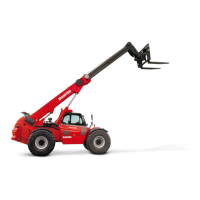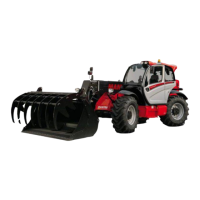(06/03/2012) 110-01-M184EN
110
5
OPTIONS - ATTACHMENTS CHARACTERISTICS
AND SPECIFICATIONS
DESCRIPTION OF THE COMPONENTS
The compressor
The compressor (Ref. 1) is the organ which makes it possible to:
• convey the uid through the suction circuit, in a gaseous state, from the evaporator at low pressure
and low temperature.
• compress the uid and transmit it at high pressure and temperature to the condenser.
The condenser
The condenser (Ref. 2) is a heat exchanger which transmits the heat recovered by the evaporator by
means of the fan to the outside and causes condensation of the uid at high pressure.
The receiver (or drier) lter
The lter (Ref. 3) is the main protective element of the system. Its functions are as follows:
• To lter out solid particles, if any, carried by the uid, as they could damage the compressor or block
the regulator.
• Dehumidify the uid oil and protect the circuit elements from:
corrosive agents,
freezing of the moisture at the regulator outlet to prevent blocking of the system.
• Keep the uid in the liquid state thereby forming a bu er tank to compensate for pressure variations,
if any. It thus contributes to absorbing pressure variation that may be generated by the compressor.
The “binary” pressure switch (Ref. 6)
Connected to the receiver lter, it is the safety element of the plant, and is sensitive to pressure variations.
It ensures safety of the system against very low pressure values or very high pressure values by acting
directly on the compressor clutch:
• Action against low pressures (<2 bar) because of lack of coolant, a leak or a block in the circuit downline.
• Action against high pressures (> 27 bar) because of incorrect cooling of the condenser, excess coolant
or a block in the circuit upline.
The expansion valve
The expansion valve (Ref. 4) is connected to the evaporator inlet.
• Expansion causes the pressure and temperature of the fluid to fall, thus cooling the air passing
through the evaporator.
• The ow is regulated in such a manner as to calibrate the amount of uid to make sure it is completely
vapourized on coming out of the evaporator.
The evaporator
The evaporator (Ref. 5) is a heat exchanger provided with a valve and a fan.
The fan sucks in air (cold) through the evporator, the moisture in the air condenses on the evaporator
ns, cools the air and pushes it out.
This heat exchange allows the coolant to evaporate at low pressure.
The antifreeze thermostat
The electric thermostat is connected to a probe tted between two ns of the evaporator.
A temperature variation of the evaporator causes a variation in the resistance of the setting of the
thermostat which acts on the compressor clutch relay.

